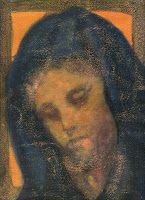Lately I have been doing a lot of monotype prints. I purchased a gelli plate a while back and I’m trying to get the hang of it. I’ve taken about four semesters of printing when I was in college; one in J.C. was an introduction: letterpress, offset, relief, serigraph, that sort of thing. Then, at Art Center I took printmaking twice and a class focused on letterpress. The into at J.C. was focused on preparing us for working with presses in publishing; strictly commercial stuff. It was the late ‘80s and the same teacher also taught desktop publishing. There were several presses in the shop and I remember the offset press the most. It’s called that because the plate is forward reading, and when inked it transfers its image to a roller which is what comes into contact with the paper. I also had to create a color separation of an image by hand. I picked a picture of a friend of mine. We cut out cyan, magenta, yellow and black transparent acetate images and when they were laid on top of each other they made a full color picture. Mine came out pretty good.
The letterpress class was a logical extension of this. We set type by hand. I made a book of my poetry, illustrated by linoleum block prints I made for them. I bought bookbinding materials including hardcover bookcloth that I got from a special store in L.A. and bound several copies for people for Christmas that year. I was really proud of them. It was a lot of work. Like many professionally handmade things, they come out looking like they were made by a machine and people never realize how much effort went into making them.
The printmaking class was about the art of printmaking. Stone Lithography, etching, drypoint, aquatint, things of this nature. I loved it. I wrote a short story for a friend whose father had died, as a way of trying to comfort her. I illustrated it and gave it to her as an unbound folio. That was the second semester. The first semester was the stone lithography (which was pretty hard, no pun intended. I don’t know how Mucha did mulitcolored prints, but that was the process in those days. I did aquatints of the holy grail, and some other things that were of no consequence. For the illustrated story the second semester, more aquatints (the story was Marina about the life of a raindrop and aquatint was perfect) the text was a photo etching of plate made from high quality prints onto acetate.
Since then, linoleum prints have become a part of my regular artmaking process, I haven’t done etching since school because it requires a press (I use a rolling pin for the lino prints) and acid baths and resin and I don’t have the space for that right now. This gelli plate doesn’t require a press either and I thought I knew enough about printmaking to give it a go. It’s soft, so it’s easy to print on and then can be cleaned and used over and over again. Because it’s soft, you can’t use hard tools to scribe, but there are plenty of soft tools to use nowadays.
Most of my prints are fairly abstract, which is ok with me because I love abstract art. You can use any kind of paint or ink and most of the info I’ve seen suggests acrylics because it’s fast drying and can be cleaned up with soap and water, and then is permanent when dry. I like Golden Open the best because it dries slower allowing for more clean up time. However, most of the acrylics I have are not Open, because for painting with acrylics, I prefer creating several layers very fast. This is also why the gelli plate is good for acrylics. It’s very hard to get a good monotype from one layer, but several can create really interesting textures.
I usually run sets. I do several prints with the same base color, then by the time I’m done, the first print is dry and ready for the second layer, and they I run through layer after layer until I have several prints that have been through the same process. The prints are all original however as any image has to be created from scratch and the plate is inked each time. It’s a learning process for sure. My latest batch is a group of winter nocturnes that look kind of like Rothko’s and that’s ok with me.























